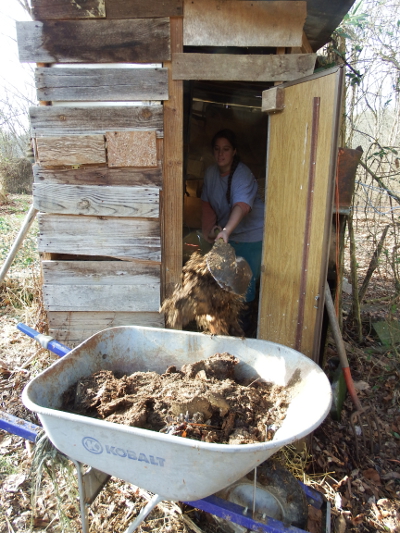
Deep bedding for ducks
 On the one hand, deep bedding with ducks
is a pain in the butt. The waterfowl's wet poop and big feet mean that
the bedding gets mashed down into matted clumps within a couple of days.
In contrast, deep bedding in a chicken coop goes a lot further because
the chicken manure is drier and the hens scratch through the bedding,
mixing the manure in.
On the one hand, deep bedding with ducks
is a pain in the butt. The waterfowl's wet poop and big feet mean that
the bedding gets mashed down into matted clumps within a couple of days.
In contrast, deep bedding in a chicken coop goes a lot further because
the chicken manure is drier and the hens scratch through the bedding,
mixing the manure in.
On the other hand, the
same wetness that makes duck manure hard to stay on top of also means
that the lower levels of the deep bedding truly compost into a perfect,
crumbly substance ready to get the spring garden off to a great start.
In this photo, Kayla is reaching the bottom of the bedding and is
hitting a bit of clay, but if you were to reach into that wheelbarrow,
you'd find lots of pillbugs and other microorganisms happily digesting
the manure, straw, and leaves.
I'm always keeping notes
on how far my deep bedding goes because I dream of someday having enough
for my entire garden without bringing in off-farm manure. Our main
chicken coop (which houses the layers year-round) made enough compost
this year for 20 garden beds (about 300 square feet), while the coop
that houses our summer broilers made enough compost for 15 beds (about
225 square feet).
Over the course of a year, we plant about 220 vegetable beds, which
means our chickens only provide 16% of the fertility we need (without
even considering our woody perennials).
Of course, we're slowly developing other homegrown sources of compost. Last summer, I was thrilled to discover that a year of humanure
feeds about 72 square feet beneath our woody perennials, and the goats
will help us take another step in the manure-self-sufficiency direction
(once I figure out the level of composting necessary to kill the weed
seeds in their discarded hay). But there's still a lot of garden that
needs to be fed, so I guess Mark will have to keep shoveling horse manure for the foreseeable future.
Want more in-depth information? Browse through our books.
Or explore more posts by date or by subject.
About us: Anna Hess and Mark Hamilton spent over a decade living self-sufficiently in the mountains of Virginia before moving north to start over from scratch in the foothills of Ohio. They've experimented with permaculture, no-till gardening, trailersteading, home-based microbusinesses and much more, writing about their adventures in both blogs and books.
Want to be notified when new comments are posted on this page? Click on the RSS button after you add a comment to subscribe to the comment feed, or simply check the box beside "email replies to me" while writing your comment.
- Remove comment

- Remove comment
